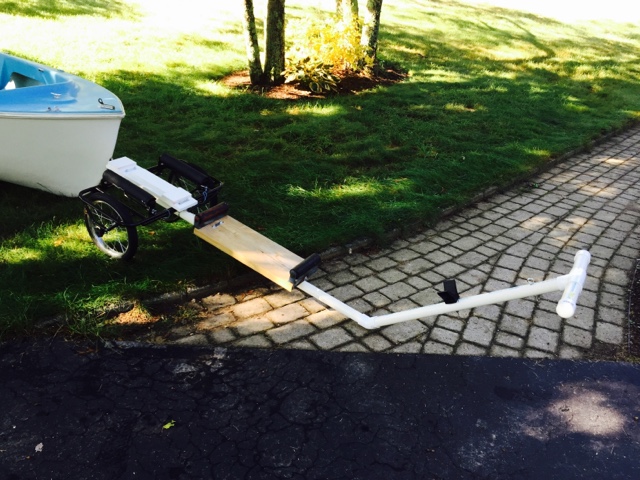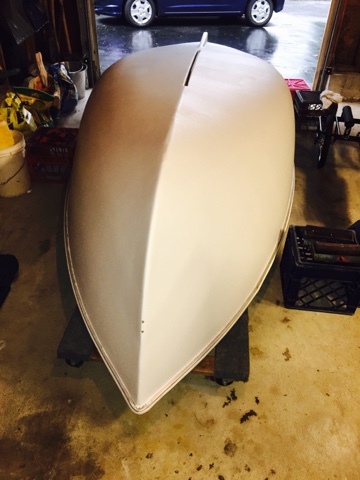Well, this past Saturday (8/30/15), I had the opportunity to sail this little craft for the first time. I was able to get a small trailer from a fellow sailor at the Massabesic Yacht Club that fits perfectly. I only had to adjust the bow mount and it doesn't even need a winch. When I launched the boat, it just floated off. When I retrieve the boat after sailing, I just pulled it up by the bow line.
(As a reminder, we are NOT allowed to get our feet in the water at Massabesic Lake since it is a reservoir for Manchester, NH)
The mast crutch was made out of a scrap 2x6. I put two bent bolts that go into the rudder mount. Everything was strapped down with ratchet straps. The whole thing is fairly light so it tows easily with my wife's 2007 Honda CR-V.
On arriving at the Yacht Club, a friend came over and helped me step the mast. It is light enough to step yourself but an extra set of hands is always welcome. Once stepped, I attached the two shrouds and forestay. I also made sure I put the windex, jib and main halyards on the mast BEFORE stepping it.
I then launched the boat, and rigged it in the water from the dock. I think the whole operation took maybe 20 minutes. (Derigging was equally as easy). One must remember to drop down the center board before sailing off and raising it before pulling it back out.
From these pictures, you can see I sailed it away from the dock in very light air. Fortunately, as you can see in the bottom picture, there was a line of air farther out from the mooring field, so I could get the boat moving some.
It was a blast to sail. Being used to sailing a Catalina 22, I was reminded how responsive (and tippy!) a small dinghy can be. I kept her pointed up the whole time (a good thing) but felt very safe in her.
The only complaints are the jib and jib sheets. The jib luff cannot be tightened - it is either too long or is stretched. I may make another jib for it out of a scrap sail over the winter. The cleats for the jib sheets are a little iffy with holding the trim under load. I'd rather have cam cleats and may raid my Catalina for a few that are not being used, or just buy new ones. Fortunately, parts for a dinghy are inexpensive when compared to my Catalina which in turn is cheap compared to a 40 footer :-)
As a 6' 1" 200 lb. 50-year old, I spent most of my time sitting or kneeling on the floor of the cockpit. That's not going to work for too long. So, I am already planning on adding two benches (my early version of the Kingfisher does not have the seats that newer ones have - see other pictures). I will make these out of wood - preferably something classy looking.
Other improvements I think I'll consider are:
- painting the topsides, inside of the cockpit and all the blue.
- adding a boot stripe and maybe painting the bottom a different color (maybe even use VC17 although I don't intend on ever leaving it in the water)
- Give her a name - I'm thinking of "Barchetta", which is Italian for "little boat". No, I'm not painting her red - don't ask Rush fans :-)
(Update 9/4... My friend and fellow sailor Wally V (Hunter 23 "Freebird") came out on the club launch and took this picture of me under sail :-)
















